Arts & Culture
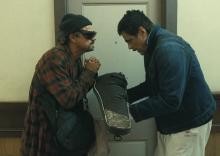
“You know what freedom is? No fear,” says Benicio Del Toro’s Sensei Sergio in One Battle After Another, inspiring Leonardo DiCaprio’s Bob Ferguson to face an authoritarian manhunt right on his family’s tail. While both Bob and Sergio are, in certain senses, doomsday preppers, they react quite differently to an impending threat. And how we react when we feel under threat makes a big difference, both to our own wellbeing and to the movements we care about.
In the film, Bob is an in-hiding former member of the far-left revolutionary group called the French 75. For the last 16 years, while raising his daughter Willa in the sanctuary city of Baktan Cross, he’s lived with an intense paranoia about her safety and the potential of his old life coming back to haunt them both.

You may have heard that, at Charlie Kirk’s memorial service, Erika Kirk said that she forgave her husband’s assassin.
You may have also heard that only a few minutes later, President Donald Trump said that while Charlie Kirk “did not hate his opponents—he wanted the best for them,” he was different: “I hate my opponent, and I don’t want the best for them!” This moment got a lot of attention, understandably so, but another moment stuck out to me even more. And even though we’re almost a week and a half removed from the memorial service, I think it’s still worth exploring today.

Oscar season hasn’t even started, and 2025 is already shaping up to be a strong year at the movies. We’ve seen small-budget standouts, from the thought-provoking body horror of Together to the empathetic dramedy of Sorry, Baby. Even the superhero blockbusters—Superman, Fantastic Four—had more to say about justice and community than I’ve come to expect from spandex cinema. And then there was Sinners, which was perfect.

When Robert Redford was 18 years old, his mother died—suddenly and young—following complications from delivering twin girls who did not live long. This harrowing loss left young Redford disillusioned with God. “I’d had religion pushed on me since I was a kid,” he would tell Michael Feeney Callan, his biographer. “But after Mom died, I felt betrayed by God.”
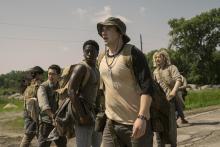
“I keep hoping that gets easier,” one character in The Long Walk says, shortly after witnessing the gruesome execution of a companion. Still visibly shaken, Cooper Hoffman’s character Ray Garraty replies: “That’s what I’m afraid of.”
A 2025 film adapted from the 1979 novel by Stephen King, The Long Walk depicts a dystopian near future where young boys from all over the United States voluntarily compete in a contest to walk at 3 mph continuously across hundreds of miles—with those who repeatedly fall below the pace being shot dead until there is one winner of glory and riches.
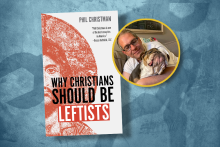
This interview is part of The Reconstruct, a weekly newsletter from Sojourners. In a world where so much needs to change, Mitchell Atencio and Josiah R. Daniels interview people who have faith in a new future and are working toward repair. Subscribe here.
I’m going to let you in on a little secret: If you see a book about politics published in 2025, it’s very possible the world is different than what the author hoped for when they pitched it.

Why is it that, in our current era, the most emotionally resonant art often lurks behind the silliest premise? It has become something of a running joke in the rapidly emerging KPop Demon Hunters fan community that the movie, on the basis of the title alone, is incredibly difficult to recommend to people without being laughed off. KPop Demon Hunters may have a campy hook, but it explores ideas that cut to the heart of human experience.
KPop Demon Hunters is about Huntr/x, a trio of Korean singers whose pop star status conceals their true role as mystical demon hunters tasked with creating a supernatural barrier called the Honmoon. Through the power of music, this Honmoon keeps soul-consuming demons at bay from the world. When the evil demon king Gwi-Ma sends a demon boy band called the Saja Boys to fight fire with fire (or pop song with pop song,) our heroes’ defense against the demon army begins to break. And the darkest secret? Rumi, the group’s lead singer and the film’s protagonist, is actually part-demon herself.

Shortly after Hamilton was first released a decade ago, I found myself singing along to it rather loudly while building a new IKEA bed frame in a group house I had just founded.
As I belted out the words to one of the more familiar songs from Act 1, “My Shot,” my new housemate poked her head around the corner and added her own voice to the mix. “I’m just like my country / I’m young, scrappy and hungry,” we sang in unison, creating a moment of joy and connection between a Catholic and a Protestant that provided the foundation for a lasting friendship and community-building work.

“At their best, my videos are life-changing,” CJ The X tells me, with a laugh that acknowledges the immensity of the claim. From the mouths of many other internet creators, this statement might sound ludicrous—but the comments on CJ’s channel will reveal that they are not exaggerating.
“Every CJ The X video gives me about 5 metaphysical panic attacks before giving me some sort of closure,” one commenter remarked.

Aymann Ismail has a variety of identities that keep him busy. When I asked him to tell me about himself, he replied, “I’m a journalist, a parent, and a full-time Arab American.” He is also the author of the new memoir, Becoming Baba: Fatherhood, Faith, and Finding Meaning in America.
One of the things I appreciate most about Ismail, who is Muslim, is the way he subtly incorporates reflections on his faith into his writing. In Becoming Baba, Ismail relates how he sat down to read the Quran, only to vehemently disagree with what he read. This led him to explore his doubts and questions, which Becoming Baba explores in an engaging and refreshing way.

Hearing about the news of James Dobson’s death reminded me of a conversation I recently had with my sister while we were making our way to an Ethel Cain concert.
We were conversing as we hurried to the car, excited to profess our love to Willoughby Tucker, and I told my sister she was the only reason I knew about Ethel Cain—whose real name is Hayden Anhedönia. We then indulged in some cynical jokes about the “woke” impulse to cancel Anhedönia because of old social media posts, which she has since apologized for and described as “deeply shameful and embarrassing.”
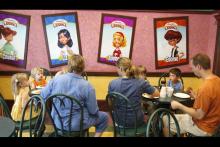
God is not up in heaven thinking up bad things to happen to you. He loves you so much and only wants the best for you. But sometimes that means you have to go through a little bit of pain and heartache. But if you trust him and you love him, he will not let you down.
These words of comfort were given by James Dobson to a young girl in an episode of a Christian radio drama created by his organization. Within these few short sentences, you can find the entirety of Dobson’s ideology: God’s love entangled with the necessity of His punishment.

I didn’t expect church to be the place where I learned 803Fresh’s “Boots on the Ground,” the latest line dance taking the nation by storm. The song, which currently has more than 14 million views on YouTube and is known for the refrain, “Where them fans at,” has been danced to by folks like Shaquille O'Neal, Ciara, Kamala Harris, Tina Knowles, and Michelle Obama. And it’s been performed everywhere, from trail rides to graduations, news broadcasts to talk shows. But when people started performing the line dance in church, not everyone was pleased.
“Some of these so call [sic] churches is night 🌙 clubs,” wrote one Facebook user in response to a viral video of a “Boots on the Ground” line dance performance at a small church. “Put them boots on the PASTOR and scoot him out of the church,” another wrote.
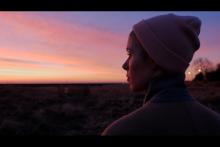
When the House passed President Donald Trump’s Big Beautiful Bill Act, House Speaker Mike Johnson gave glory to God.
Johnson, the Louisiana Republican and Christian, believes that his work and the work of the United States are divinely orchestrated. But if the so-called “Big Beautiful Bill” is truly from God, then what are we to make of cuts that negatively impact the most marginalized in our society?

IT’S BEEN ALMOST a hundred years since God created The Three Stooges, who taught us the first rule of humor: If you can’t make people laugh with a joke, then hit each other over the head with a mallet. According to their cinematic archive, no job was too challenging to fail at spectacularly, including plumber, painter, carpenter, chef, and even surgeon. They could not succeed in these endeavors because they were utterly unqualified, a can’t-do attitude that fits right in with today’s Trump administration. But the good news is, any moment now we should start laughing.
In fact, had Moe, Curly, and Larry lived into their second century, they might have been chosen as members of Robert F. Kennedy Jr.’s new Advisory Committee on Immunization Practices, ACIP for short. Since so many of RFK Jr.’s new hires have been sorely mistaken as respected experts in the field of immunology, why not The Three Stooges, whose disqualifying ineptitude could stand shoulder to shoulder with their own.
The original members of ACIP were summarily dismissed for — as far as we can tell — a strong commitment to scientific inquiry and making fact-based decisions. Also, their surprising aversion to prescribing Vitamin A as a wonder cure. (RFK Jr. is a huge vitamin A fan. He can’t get enough of it. Nor, apparently, can he get enough time in tanning beds despite the proven risk of melanoma. To his credit, RFK Jr. will put up looking tanned and fit against a cancer risk any day.)

More than once I’ve given away
all that was mine except a red pocketknife
and three changes of clothes. Even so
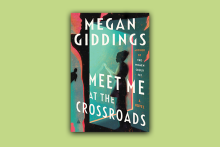
Once, a woman told me the closest thing she had to a religion was speculative fiction. Just as spiritual practices do for many believers, reading Ursula Le Guin and Octavia Butler helped her face the haunting edge of humanity’s knowledge, those parts of being alive that refuse explanation.
It’s this confrontation with mystery that Megan Giddings places at the center of her captivating novel Meet Me at the Crossroads. Seven doors appear around the world, each opening to a beautifully warped alternative dimension. Those who walk through these doors see meadows peppered with gold stones and orange deserts under purple skies — but they don’t always come back. Once people realize that the doors are “uncontrollable, unkillable and unknowable,” most ignore them or call them a hoax, aside from a few fringe religious groups. Woven with plenty of heart, this story is not so much about the nature of the unknown as the complicated ways people cope with it.
In Michigan, twins Ayanna and Olivia grow up near one of the doors, developing contrasting ideas of its meaning. Ayanna lives with their father, who raises her in a marginalized faith community that reveres the door as a divine invitation to embrace mystery. Olivia lives with their mother, a Catholic who rejects her ex-husband’s religion as heretical. Amid the tense family dynamics, the sisters remain close until, upon entering the door as teenagers, Olivia disappears.
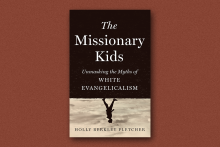
When Holly Berkley Fletcher was a child, she once heard her missionary parents “literally introduced as ‘Super Christians.’” In a white American evangelical culture that idolizes missionaries in this way, how do we speak honestly about the harm missions too often leave in their wake? In Fletcher’s new book The Missionary Kids: Unmasking the Myths of White Evangelicalism (Broadleaf Books), missionaries’ grown children offer a complex and fascinating perspective.
Fletcher—a historian, former CIA analyst, and missionary kid (MK) herself—draws on extensive research, her own experience as an MK, and surveys and interviews with fellow MKs to present a wide-ranging look at MKs’ experiences. Without losing sight of the noble intentions of most missionaries and the good work that many of them do, she pulls back the curtain on the perceived saintliness of missionaries, uncovering an alarming multitude of systemic harms. In doing so, she exposes key myths at the core of white American evangelicalism itself.
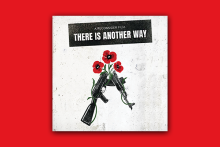
Combatants for Peace
The film There is Another Way profiles former Israeli and Palestinian combatants working toward collective liberation, showing the courage required to break cycles of hatred. “We are strong. We are fierce. But we will not meet them with their violence,” says one activist. Reconsider
The Grit of Incarnation
You Can Trust a God with Scars: Faith (and Doubt) for the Searching Soul presents a Christianity that embraces doubt and a God who understands suffering intimately. Jared Ayers uses art, scripture, music, and literature to explore “the dazzling mystery ... that the Maker stooped to become what had been made.” NavPress
Justice Can Prevail
Geared toward readers ages 8-12, A Sea of Lemon Trees: The Corrido of Roberto Alvarez, by María Dolores Águila, is a lyrical telling of the first successful school desegregation case, Alvarez v. Lemon Grove, two decades before Brown v. Board of Education. Roaring Brook Press

WHEN THE CREDITS rolled for the live-action remake of How to Train Your Dragon, I didn’t expect to think of Catholic theologian G.K. Chesterton. But it makes perfect sense. What better time to remember the words of the “prince of paradox” than during a kid’s movie about a dragon slayer who becomes a dragon friend, all with the backdrop of Iceland’s natural beauty and composer John Powell’s engrossing musical score. The film easily summoned these words from Chesterton’s 1909 essay collection Tremendous Trifles: “The world will never starve for want of wonders; but only for want of wonder.” Beauty and wonders surround us. And if we’re willing to stop and listen, such gifts can dislodge our biases and fears.
The new film focuses on Vikings who live on the isle of Berk, where they fight dragons for survival and space. The socially awkward and soft-spoken Hiccup frequently clashes with his father, Stoick, the Viking leader. Hiccup eschews Berk’s traditional masculine norms; he feels more curiosity than bloodlust toward the dragons. Yet, Hiccup gets his chance to prove his worth when he seems to kill the most feared dragon, Night Fury.
Hiccup is a normal kid: He has crushes, insecurities, and familial angst. Director Dean DeBlois knew Hiccup was joining a long line of powerful but unassuming heroes. “There’s a time-honored tradition of protagonists who are just regular kids but have a transformative bond with something amazing,” Dean told Sojourners, calling to mind Luke Skywalker from Star Wars and Elliott Taylor from E.T. But these seemingly unexceptional heroes are in fact gifted in their capacity for awe.